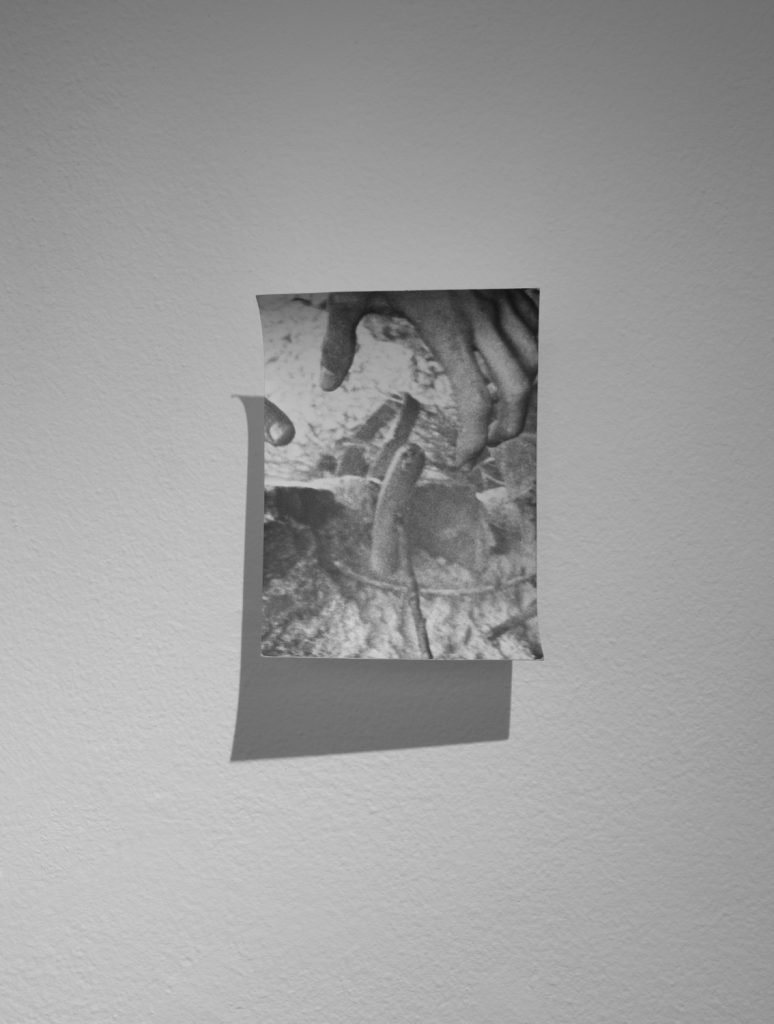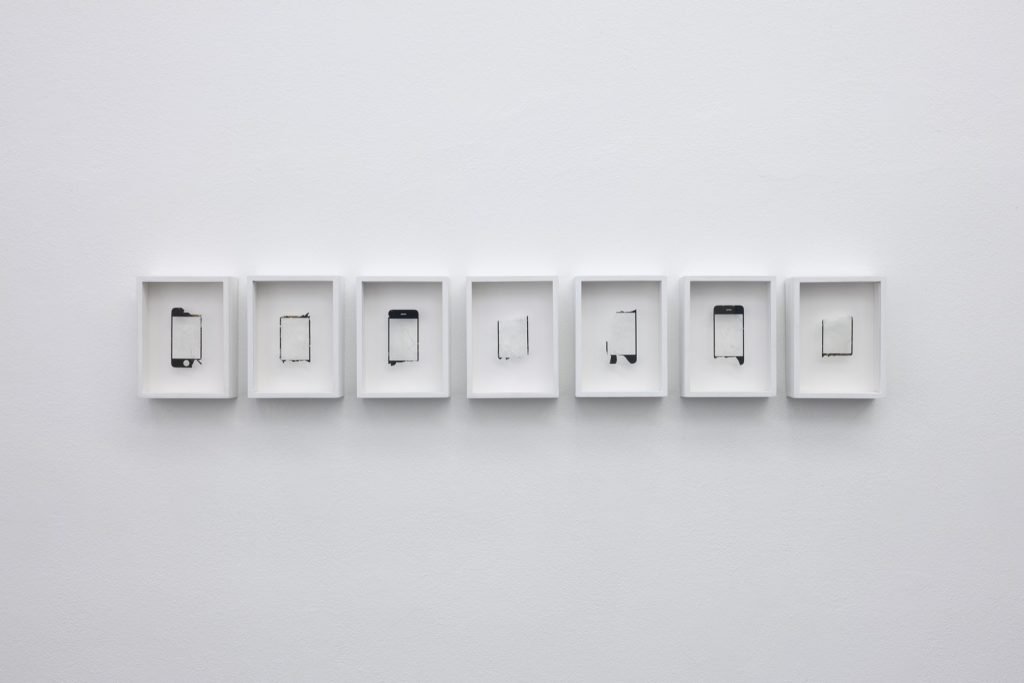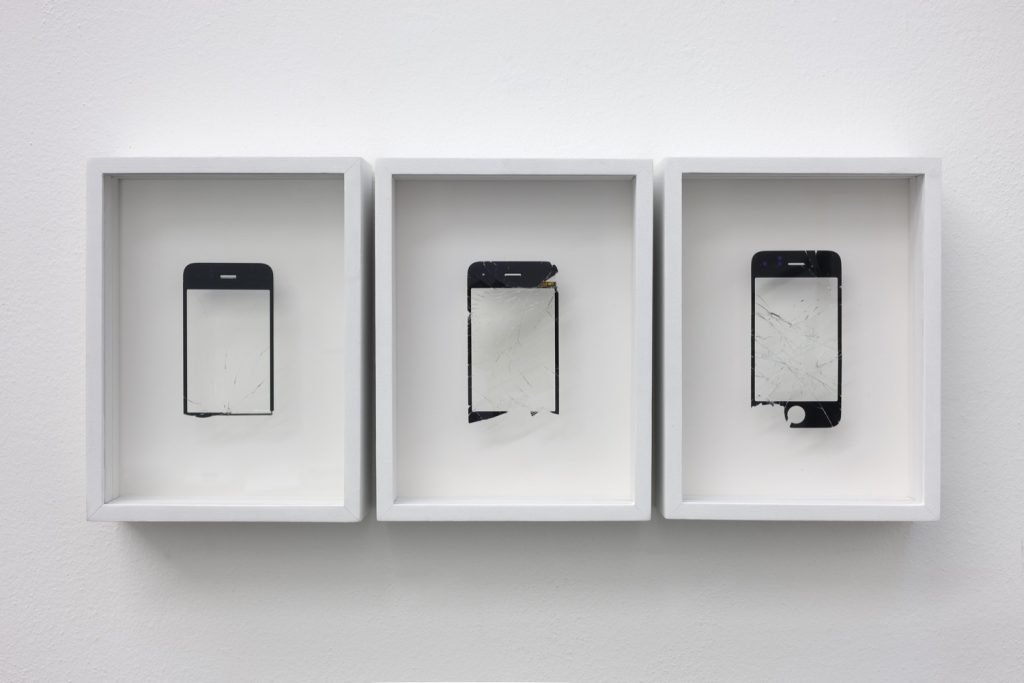









“Catchers” di Luca Panaro
L’artista cerca continuamente di afferrare qualcosa. Così la mano impaziente immortalata nell’immagine anonima restituisce la vibrante tensione del gesto. Simone Bergantini è come “l’acchiappatore” di J. D. Salinger. Ma cosa può prendere? Forse immagini condivise.
Probabilmente soltanto la sensazione che queste possano esistere soltanto lì. Può darsi si tratti di un ambiente in cui siamo talmente immersi da non avere ancora acquisito gli strumenti per governarlo. Al contrario possiamo pensare che il controllo tanto caro a chi ci ha preceduto sia ormai una categoria in disuso. È plausibile che l’apertura all’indefinito e il mancato tentativo di delinearne i confini sia un nuovo scenario a cui dobbiamo abituarci. Certo, è difficile. Eppure all’artista spetta l’ingrato compito di acchiappare qualcosa del proprio tempo. Facebook, Twitter e gli smartphones rappresentano oggi la realtà in cui muoversi. Un ambiente fatto di schermi, superfici piatte, immagini
retroilluminate, notizie che corrono su tablets e laptops, pronti a essere estratti dalle loro custodie per aumentare
le informazioni su ciò che ci sta di fronte, oppure per
evadere completamente da quella realtà prontamente sostituita da qualcosa di fluido. I contenitori sono diventati più importanti dei contenuti. Sono su Instagram! Non importa cosa carico sul mio profilo. Ho l’iPhone! Non mi interessa quali fotografie potrò veicolare con quel mezzo. Lo schermo di un telefono, anche se rotto, è più potente del suo contenuto. Stiamo parlando di superfici: monocromatiche, piatte, prive di sfondamento
prospettico, anti-narrative, ammiccanti alla grafica.
Qualcosa dunque l’artista sta afferrando. Forse una probabile estetica del domani? La produzione di immagini così orgogliosamente bidimensionali non ha precedenti nella storia. Sembra finito il tempo in cui si rincorreva con frustrazione la plasticità tipica della scultura. Oggi le immagini sono prodotte da dispositivi ultrapiatti che non modellano la realtà, piuttosto la registrano in modo altrettanto lineare, la sommano ad altri livelli di realtà
basandosi su un principio additivo. Dunque il racconto subisce una mutazione, spariscono personaggi e luoghi, lasciando il posto a oggetti e superfici lisce. Viviamo in un’epoca caratterizzata dall’eccesso d’informazioni che atrofizzano le nostre capacità cognitive, invece di
potenziarle. L’arte quindi non deve contribuire a generare questo affaticamento informativo, per questo sta cambiando registro, prendendo gradualmente le distanze dal tessuto narrativo che porta all’atrofia del pensiero. La strada verso cui si sta indirizzando l’arte predilige la citazione del reale alla realtà stessa. Una parte a discapito del tutto. Questa frammentazione favorisce l’apertura, permette di ridisegnare i confini dell’autorialità, consente di percepire nella ricerca artistica i cambiamenti strutturali rispetto ai modelli di vita che tutti stiamo adottando. Una nuova iconografia quindi sta facendo capolino nonostante le resistenze di certi osservatori, sempre pronti a farcire ogni immagine di riferimenti politici e sociali. È possibile che questa disperata ricerca di significato, rivolta esclusivamente all’indietro, sia destinata a sfumare in nuove pratiche, più efficaci delle precedenti nel registrare la realtà sfuggente in cui viviamo. E allora l’artista come il catcher nel baseball si posiziona a ricevere i tiri del lanciatore che spesso è lui a suggerire. Oggi la palla è scagliata dalla tecnologia, l’artista deve predisporsi a riceverla armato di maschera e pettorina, ma deve anche essere in grado di chiamarla.
Per farlo però deve conoscere bene il gioco, prevedere le traiettorie, non può distrarsi volgendo la testa al passato, verrebbe meno una sua pronta reazione al presente, quella che consente il tiro immediato, veloce e preciso
verso il futuro. Spesso Bergantini non utilizza la tecnologia direttamente, ne riceve le suggestioni e cerca di ribatterle attraverso immagini e oggetti. Preferisce fermare il flusso degli eventi e raccoglierne le tracce come farebbe un archeologo. Ma invece di occuparsi del passato è chiamato a direzionare il proprio sguardo altrove, dunque su un terreno scivoloso, ma affascinante; rischioso, ma pieno delle soddisfazioni che può riservare
ciò che ancora non si conosce. E qui interveniamo noi, i fruitori di questa pratica, la partita si disputa affinché il messaggio arrivi a qualcuno che dovrà seguire il gioco anche in assenza delle informazioni che lo hanno alimentato. Dunque noi, soli al cospetto di tre grandi superfici cromatiche e aniconiche. Noi, privi di un appiglio semantico che solletichi un qualche interesse pregresso. Noi, chiamati a gestire in solitudine una specie di
vertigine. Un piacere che proviene dalla tecnologia, dalla cancellazione del dolore costituito dall’abitudine del suo utilizzo.
Luca Panaro
“Catchers” di Luca Panaro
The artist constantly tries to catch something. In the same way, the impatient hand in the anonymous image communicates the vibrant anxiety of the gesture. Simone Bergantini is like J. D. Salinger’s catcher. But what can he really catch? Some shared images, maybe. Or maybe just the sensation that they can exist only in that dimension – the web. It may be a dimension by which we are so absorbed that we do not know how to rule that yet.
On the contrary, we may think that the control, which those who existed before us cared about has been abandoned now. It is likely that the tendency to embrace the unclear and the unsuccessful attempt to define its boundaries represents a new scenario, which we have to get familiar to. It is hard, of course. However, it is the artist who has the ungrateful duty of catching something from his – or her – own age. Facebook, Twitter and
smartphones – these are the new realities we live in. A world made of screens, flat surfaces, retro illuminated images, news scrolling on tablets and laptops, which we are always about to take off from their case to increase the information about our world or to completely escape from that reality immediately replaced by something fluid.
The container has become more important than the content. Follow me on Instagram! It does not matter what I upload on my profile. I have an iPhone! I do not care which photos I will take. The screen of a phone, though
broken, is more powerful than what it contains. We are talking about surfaces – monochromatic, flat, lacking any perspectives, anti-narrative, firmly linked to graphics. So the artist is catching something. A possible future aesthetics, maybe. The production of images, which are so proudly two-dimensional, is unprecedented in history.
It looks like the age when the frustrating artist used to chase the plasticity of sculpture is now over. Today’s images are created by super-flat devices, which do not shape reality – they rather record it in a likewise linear way, they add it to other level of reality on the base of an additional principle. Consequently, the narration undergoes a mutation, and characters and places disappear – what is left are flat surfaces and objects. We live in an era overwhelmed by information, which damage our cognitive skills instead of pumping them. So art is not supposed to contribute to the creation of this informative fatigue – this is the reason why the register of art is changing, gradually taking distance from the narrative textile, which leads to the atrophy of the mind. The path, which art is taking consists in choosing quotes from the real instead of reality itself. One part to the detriment of
the whole. This fragmentation supports an open-minded attitude, it allows to reshape the boundaries of authority and to feel the structural changes in the artistic research compared to the models of life, which we are all
embracing. A new iconography is rising notwithstanding the opposition of some critics, always ready to find political and social references in any image. It is possible that this desperate search for a meaning, exclusively
pointing towards the past, is destined to dissipate in new practices, more effective than the previous ones in recording the fading reality we live in. So the artist, like the catcher in a baseball game, is ready to receive the balls from the pitcher – those balls, which the catcher himself often suggests. Today, that pitcher ready to throw the ball is technology, and the artist, with his – or her – mask and chest protector, has to be ready to receive that ball as well as to call it. In order to do that, the artist has to know the game very well and to expect the trajectories.
He – or she – cannot distract from the game looking at the past since he – or she – would not be ready to face the present, to receive the immediate ball, the quick and precise ball heading to the future. Bergantini does not often use technology directly – he receives its suggestions and tries to hit them back through images and objects. He prefers to stop the flow of events and collect its traces, like an archeologist. However, instead of dealing with the past he is called to direct his own sight somewhere else, on a slippery though fascinating surface. This is dangerous but rich with the satisfactions typical of something which is still not known. And this is
our turn, the beneficiaries of this practice – the game takes place so that the message reaches someone who has to follow the game even without the information, which have alimented it. It is just us, alone, face to face with three big chromatic surfaces, which lack icons. Us, lacking a semantic handhold, which piques any previous interest. Us, who are called to manage a sort of vertigo, alone. A pleasure coming from technology, from erasing the pain represented by the routine of its use.